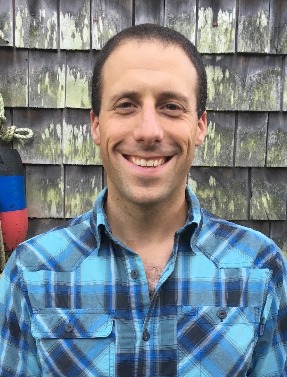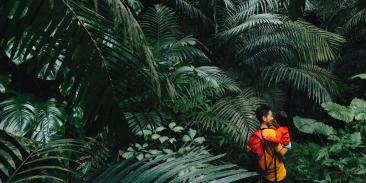
Jamie Collins
Marine Biogeochemical Scientist
Contact
Remote OfficeWork
Areas of expertise:
Carbon and nutrient cycles in ocean ecosystems; science, ethics and policy of marine carbon dioxide removal (CDR), global geoengineering technologies, and other climate interventions; blue carbon; climate change; Antarctic research; science and policy of oil spill and hazardous materials remediation
Description
As a member of EDF’s oceans science team, Jamie asks fundamental questions about the earth’s carbon cycle to uncover, quantify and operationalize solutions for climate change and other environmental challenges. He is a respected international voice on the science, ethics and policy surrounding marine CDR and other geoengineering technologies, with service on multiple expert-level panels and committees convened by the World Climate Research Programme, American Geophysical Union, and U.S. National Science Foundation.
He leverages a unique background as an oceanographer, diplomat, environmental policy practitioner and leader in Federal and state government to translate complex science for EDF staff, external partners, Fortune 500 business leaders, and senior U.S. and international government decision-makers on issues ranging from carbon dioxide removal and geoengineering to sustainable fisheries management and the fate and transport of pollutants in marine and coastal ecosystems.
While on official leave from EDF from 2022-2024, Jamie served as the United States’ Senior Defense Official and Defense Attaché for Barbados and the Eastern Caribbean, administering a $21.2M defense and climate assistance portfolio for seven Small Island Developing States.
Background
Prior to joining EDF as a postdoctoral fellow in 2021, Jamie was as a Moore/Sloan and Washington Research Federation Fellow in Data Science at the University of Washington and, for two years, directed the emergency cleanup of oil and hazardous materials spills for the state of Oregon. He is an active duty U.S. Coast Guard veteran and currently serves as an officer in the U.S. Coast Guard Reserve. His scientific research on climate change and stratospheric ozone depletion has taken him to Antarctica three times, and he has spent more than 800 combined days at sea as a scientist and military officer.
Jamie is a Guest Investigator at the Woods Hole Oceanographic Institution and has served as an adjunct professor in environmental science and emergency management at Portland State University and the U.S. Coast Guard Academy. He is a member of the World Climate Research Programme’s Safe Landing Climates Working Group on anthropogenic perturbation of the global carbon cycle. Jamie is a licensed merchant mariner and has been certified as a Type 1 Incident Commander and Liaison Officer under the National Incident Management System.
Education
Ph.D., Chemical Oceanography, Massachusetts Institute of Technology/Woods Hole Oceanographic Institution Joint Program in Oceanography
M.E.Sc., Marine Biogeochemistry, Yale School of the Environment
B.A., Political Science, Yale College
Publications
Buma, B., D. R. Gordon, K. M. Kleisner, A. Bartuska, A. Bidlack, R. DeFries, P. Ellis, P. Friedlingstein, S. Metzger, G. Morgan, K. Novick, J. Sanchirico, J. R. Collins, A. J. Eagle, R. M. Fujita, E. Holst, J. M. Lavallee, R. N. Lubowski, C. Melikov, L. A. Moore, E. E. Oldfield, J. Paltseva, A. M. Raffeld, N. A. Randazzo, C. Schneider, N. Uludere Aragon, and S. P. Hamburg. 2024. Expert review of the science underlying nature-based climate solutions. Nature Climate Change 14: 402-406. doi:10.1038/s41558-024-01960-0.
Fujita, R. M., S. Augyte, J. Bender, P. Brittingham, A. H. Buschmann, M. Chalfin, J. R. Collins, K. A. Davis, J. B. Gallagher, R. Gentry, R. L. Gruby, K. M. Kleisner, M. Moritsch, N. Price, L. Roberson, J. Taylor, and C. Yarish. 2023. Seaweed blue carbon: Ready? Or Not? Marine Policy 155: 105747; doi:1016/j.marpol.2023.105747.
Loomis, R., S. R. Cooley, J. R. Collins, S. Engler, and L. Suatoni. 2022. A code of conduct is imperative for ocean carbon dioxide removal research. Frontiers in Marine Science 9: 872800; doi:10.3389/fmars.2022.872800.
Bowman, J. S., B. A. S. Van Mooy, D. P. Lowenstein, H. F. Fredricks, C. M. Hansel, R. Gast, J. R. Collins, N. Couto, and H. W. Ducklow. 2021. Whole community metatranscriptomes and lipidomes reveal diverse responses among Antarctic phytoplankton to changing ice conditions. Frontiers in Marine Science 8: 593566; doi:10.3389/fmars.2021.593566.
Farnelid H., K. Turk-Kubo, H. Ploug, J. E. Ossolinski, J. R Collins, B. A. S. Van Mooy, and J. P. Zehr. 2019. Diverse diazotrophs are present on sinking particles in the N. Pacific Subtropical Gyre. The ISME Journal 13: 170-182; doi:10.1038/s41396-018-0259-x.
Becker, K. W., J. R. Collins, B. P. Durham, R. D. Groussman, A. E. White, H. F. Fredricks, J. E. Ossolinski, D. J. Repeta, P. Carini, E. V. Armbrust, and B. A. S. Van Mooy. 2018. Daily changes in phytoplankton lipidomes reveal mechanisms of energy storage in the open ocean. Nature Communications 9: 5179; doi:10.1038/s41467-018-07346-z.
Collins, J. R., H. F. Fredricks, J. S. Bowman, C. P. Ward, C. Moreno, K. Longnecker, A. Marchetti, C. M. Hansel, H. W. Ducklow, and B. A. S. Van Mooy. 2018. The molecular products and biogeochemical significance of lipid photooxidation in West Antarctic surface waters. Geochimica et Cosmochimica Acta 232: 244–264; doi:10.1016/j.gca.2018.04.030.
Collins, J. R., P. D. Fucile, G. McDonald, J. E. Ossolinski, R. G. Keil, J. R. Valdes, S. C. Doney, and B. A. S. Van Mooy. 2018. An autonomous, in situ light-dark bottle device for determining community respiration and net community production. Limnology & Oceanography: Methods 16: 323-338; doi:10.1002/lom3.10247.
Laber, C. P., J. E. Hunter, A. F. Carvalho, J. R. Collins, E. Hunter, B. Schieler, E. Boss, K. More, M. Frada, K. Thamatrakoln, C. Brown, C. M. L. Haramaty, J. E. Ossolinski, H. F. Fredricks, J. I. Nissimov, R. Gardella, U. Sheyn, Y. Lehahn, R. J. Chant, A. M. Martins, M. J. L. Coolen, A. Vardi, G. R. DiTullio, B. A. S. Van Mooy, and K. D. Bidle. 2018. Coccolithovirus facilitation of carbon export in the North Atlantic. Nature Microbiology 3: 537-547; doi:10.1038/s41564-018-0128-4
Fassbender, A. J., H. I. Palevsky, T. R. Martz, A. E. Ingalls, M. Gledhille, S. E. Fawcett. J. A. Brandes, L. I. Aluwihare, J. R. Collins and other participants of COME ABOARD and DISCO XXV. 2017. Perspectives on Chemical Oceanography in the 21st century: Participants of the COME ABOARD Meeting examine aspects of the field in the context of 40 years of DISCO. Marine Chemistry 196: 181-190; doi:10.1016/j.marchem.2017.09.002.
Collins, J. R., B. R. Edwards, H. F. Fredricks, and B. A. S. Van Mooy. 2016. LOBSTAHS: An adduct-based lipidomics strategy for discovery and identification of oxidative stress biomarkers. Analytical Chemistry 88: 7154-7162; doi:10.1021/acs.analchem.6b01260
Collins, J. R., B. R. Edwards, K. Thamatrakoln, J. E. Ossolinski, G. R. DiTullio, K. D. Bidle, S. C. Doney, and B. A. S. Van Mooy. 2015. The multiple fates of sinking particles in the North Atlantic Ocean. Global Biogeochemical Cycles 29: 1471-1494; doi:10.1002/2014GB005037
Collins, J. R., P. A. Raymond, W. F. Bohlen, and M. M. Howard-Strobel. 2013. Estimates of new and total productivity in central Long Island Sound from in situ measurements of nitrate and dissolved oxygen. Estuaries and Coasts 36: 74-97; doi:10.1007/s12237-012-9560-5
Reports and Publications for Government Officials and the Public
Collins, J. R., S. R. Cooley, and L. Suatoni. 2022. Ocean carbon dioxide removal methods. New York: Natural Resources Defense Council, Environmental Defense Fund, and Ocean Conservancy. 15 pp. Available at https://oceanconservancy.org/wp-content/uploads/2023/01/Oceans-CDR-22-12-B_03_locked.pdf
Collins, J. R., Boenish, R. E., Kleisner, K. M., Rader, D. N., Fujita, R. M., and Moritsch, M. M. 2022. Coastal natural climate solutions: An assessment of scientific knowledge surrounding pathways for carbon dioxide removal and avoided emissions in nearshore blue carbon ecosystems. New York: Environmental Defense Fund. 30 pp. Available at https://www.edf.org/sites/default/files/2022-10/Coastal%20Natural%20Climate%20Solutions.pdf
Collins, J. R., Boenish, R. E., Fujita, R. M., Rader, D. N., and Moore, L. A. 2022. Natural climate solutions in the open ocean: Scientific knowledge and opportunities surrounding four potential pathways for carbon dioxide removal or avoided emissions. New York: Environmental Defense Fund. 40 pp. Available at https://www.edf.org/sites/default/files/2022-10/Natural%20Climate%20Solutions%20in%20the%20Open%20Ocean.pdf
Fujita, R. M., Collins, J. R., Kleisner, K. M., Rader, D. N., Mejaes, A., Augyte, S., and Brittingham, P. A. 2022. Carbon sequestration by seaweed: Background paper for the Bezos Earth Fund - EDF workshop on seaweed carbon sequestration. New York: Environmental Defense Fund. 29 pp. Available at https://www.edf.org/sites/default/files/2022-10/Carbon%20Sequestration%20by%20Seaweed.pdf
Latest pieces
-
Seaweed blue carbon: Ready? Or Not?
Marine Policy, July 19, 2023 -
Looking to the oceans for answers to the climate crisis
EDFish Blog, November 13, 2022 -
The oceans’ twilight zone? More important than you can imagine!
EDFish Blog, June 25, 2022 -
Blue carbon: A better tomorrow begins below
EDFish Blog, May 4, 2022 -
Natural climate solutions cut a steady course through a sea of proposals for ocean carbon dioxide reduction
EDFish Blog, December 16, 2021










